TOYOTA 86 2017 Owners Manual
Manufacturer: TOYOTA, Model Year: 2017, Model line: 86, Model: TOYOTA 86 2017Pages: 428, PDF Size: 5.25 MB
Page 91 of 428
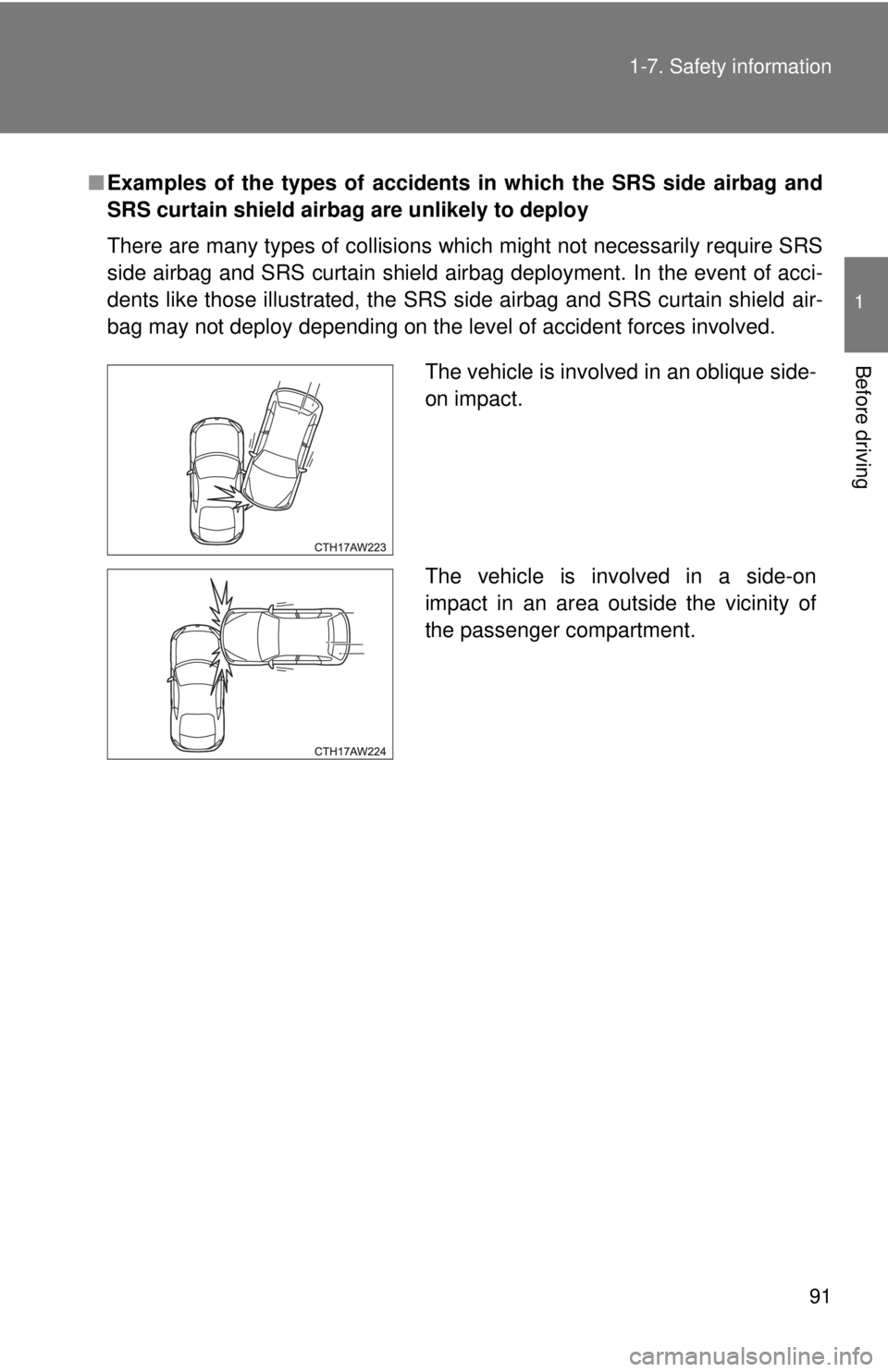
911-7. Safety information
1
Before driving ■ Examples of the types of accidents in which the SRS side airbag and
SRS curtain shield airbag are unlikely to deploy
There are many types of collisions which might not necessarily require SRS
side airbag and SRS curtain shield airbag deployment. In the event of acci-
dents like those illustrated, the SRS side airbag and SRS curtain shield
air-
bag may not deploy depending on the level of accident forces involved.
The vehicle is involved in an oblique side-
on impact.
The vehicle is involved in a side-on
impact in an area outside the vicinity of
the passenger compartment.
Page 92 of 428

921-7. Safety information
■ Examples of the types of accidents in which the SRS side airbag is
unlikely to deploy
There are many types of collisions which might not necessarily require SRS
side airbag deployment. In the event of an accident like those illustrated, the
SRS side airbag may not deploy depending on the level of accident force
involved. The vehicle strikes a telephone pole or
similar object.
The vehicle is involved in a side-on
impact from a motorcycle.
The vehicle rolls onto its side or roof.
Page 93 of 428
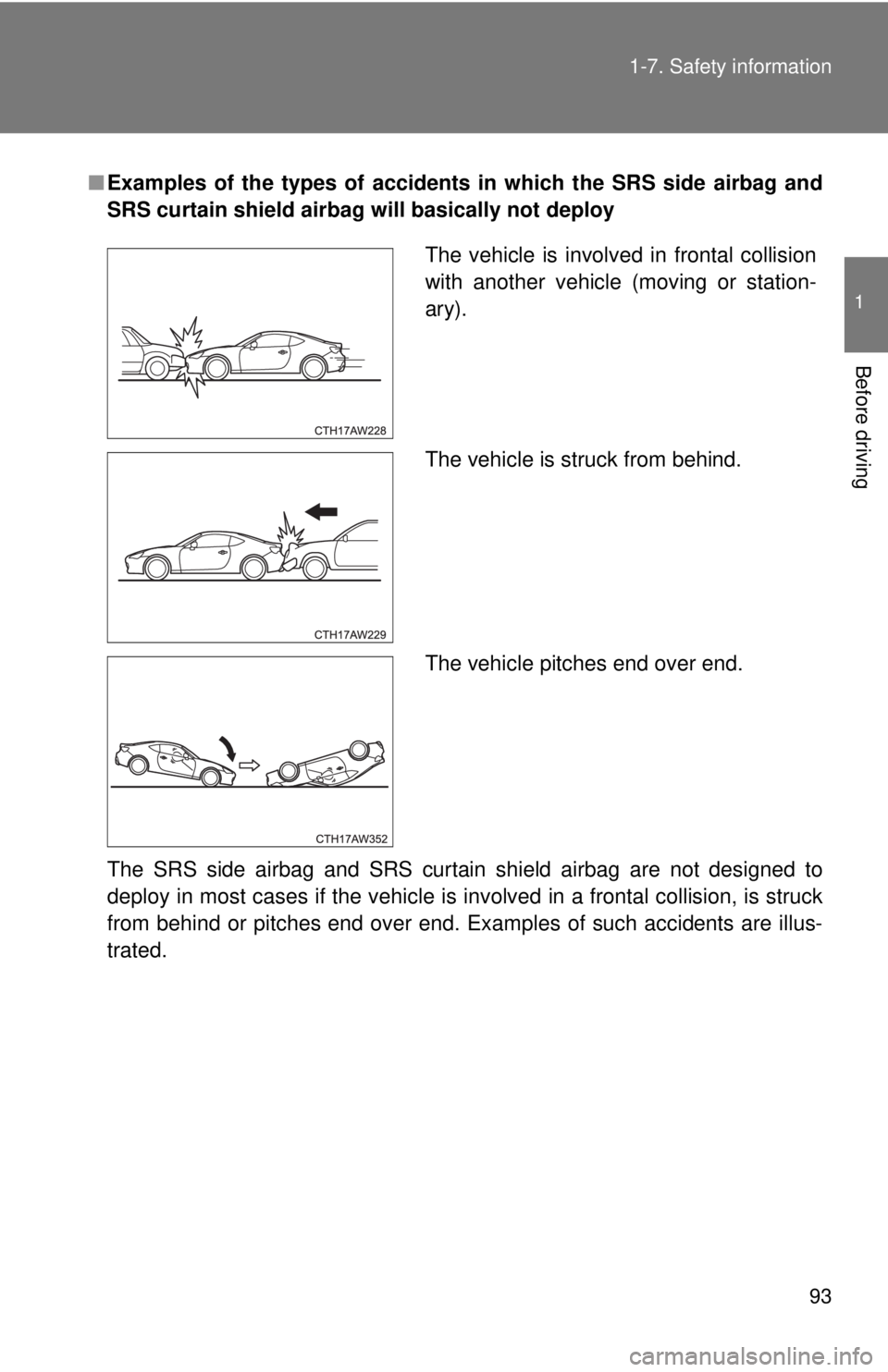
931-7. Safety information
1
Before driving ■ Examples of the types of accidents in which the SRS side airbag and
SRS curtain shield airbag will basically not deploy
The SRS side airbag and SRS curtain shield airbag are not designed to
deploy in most cases if the vehicle is involved in a frontal collision, is struck
from behind or pitches end over end. Examples of such accidents are illus-
trated. The vehicle is involved in frontal collision
with another vehicle (moving or station-
ary).
The vehicle is struck from behind.
The vehicle pitches end over end.
Page 94 of 428
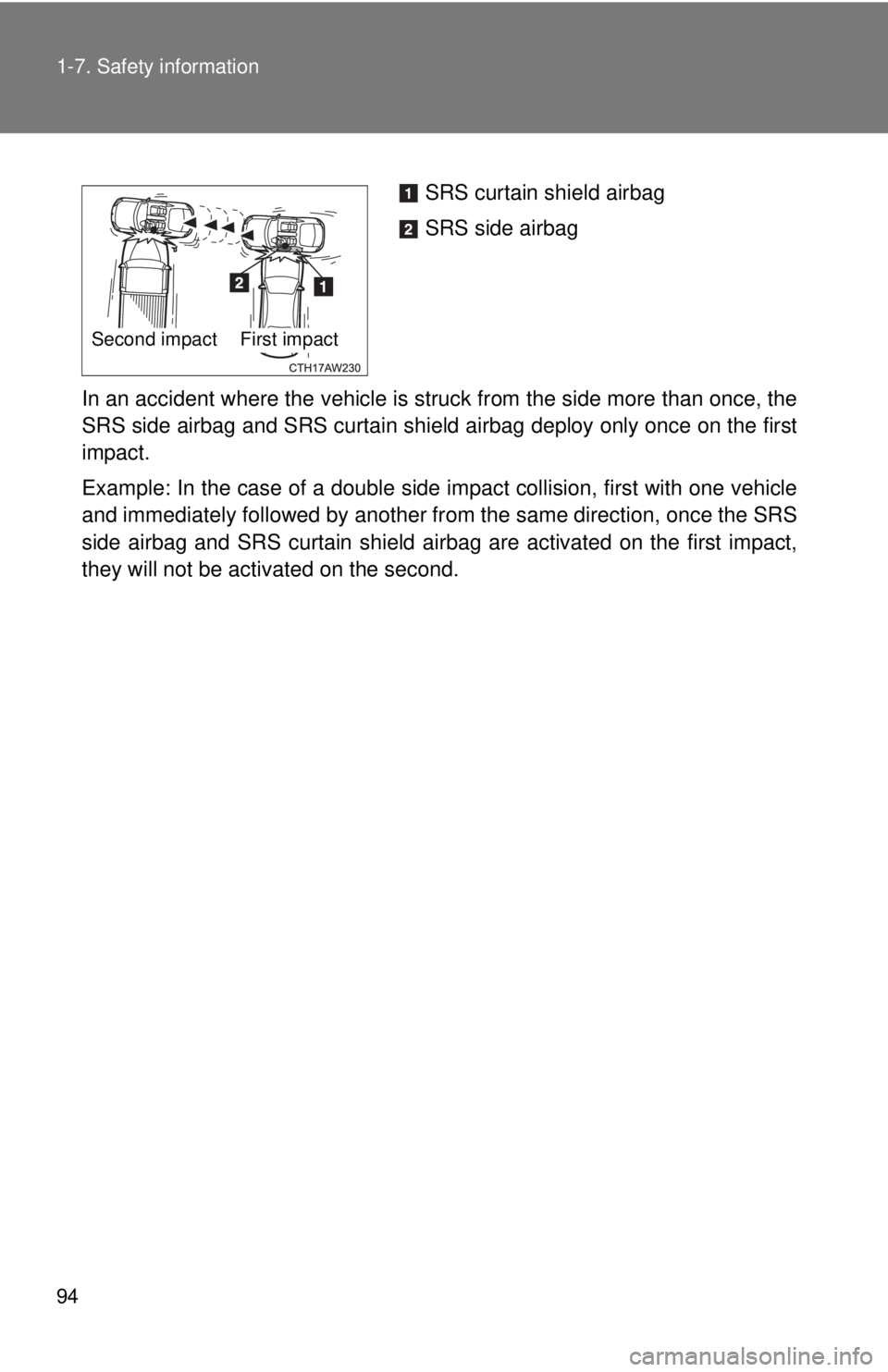
941-7. Safety information
In an accident where the vehicle is struck from the side more than once, the
SRS side airbag and SRS curtain shield airbag deploy only once on the first
impact.
Example: In the case of a double side impact collision, first with one vehicle
and immediately followed by another from the same direction, once the SRS
side airbag and SRS curtain shield airbag are activated on the first impact,
they will not be activated on the second. SRS curtain shield airbag
SRS side airbagSecond impact First impact
Page 95 of 428

951-7. Safety information
1
Before driving WARNING■ If the SRS airbags deploy
Do not touch the SRS side airbag system components around the front seat
seatback with bare hands right after deployment. Doing so can cause burns
because the components can be very hot as a result of deployment.
After deployment, do not touch any part of the SRS curtain shield airbag sys-
tem (from the front pillar to the part of the roof side over the rear seat). Doing
so can cause burns because the components can be very hot as a result of
deployment.
■ SRS side airbag and SRS curtain shield airbag precautions
The SRS side airbag and SRS curtain shield airbag are designed only to be
a supplement to the primary protection provided by the seat belt. They do
not do away with the need to fasten seat belts. It is also important to wear
your seat belt to help avoid injuries that can result when an occupant is not
seated in a proper upright position.
Page 96 of 428
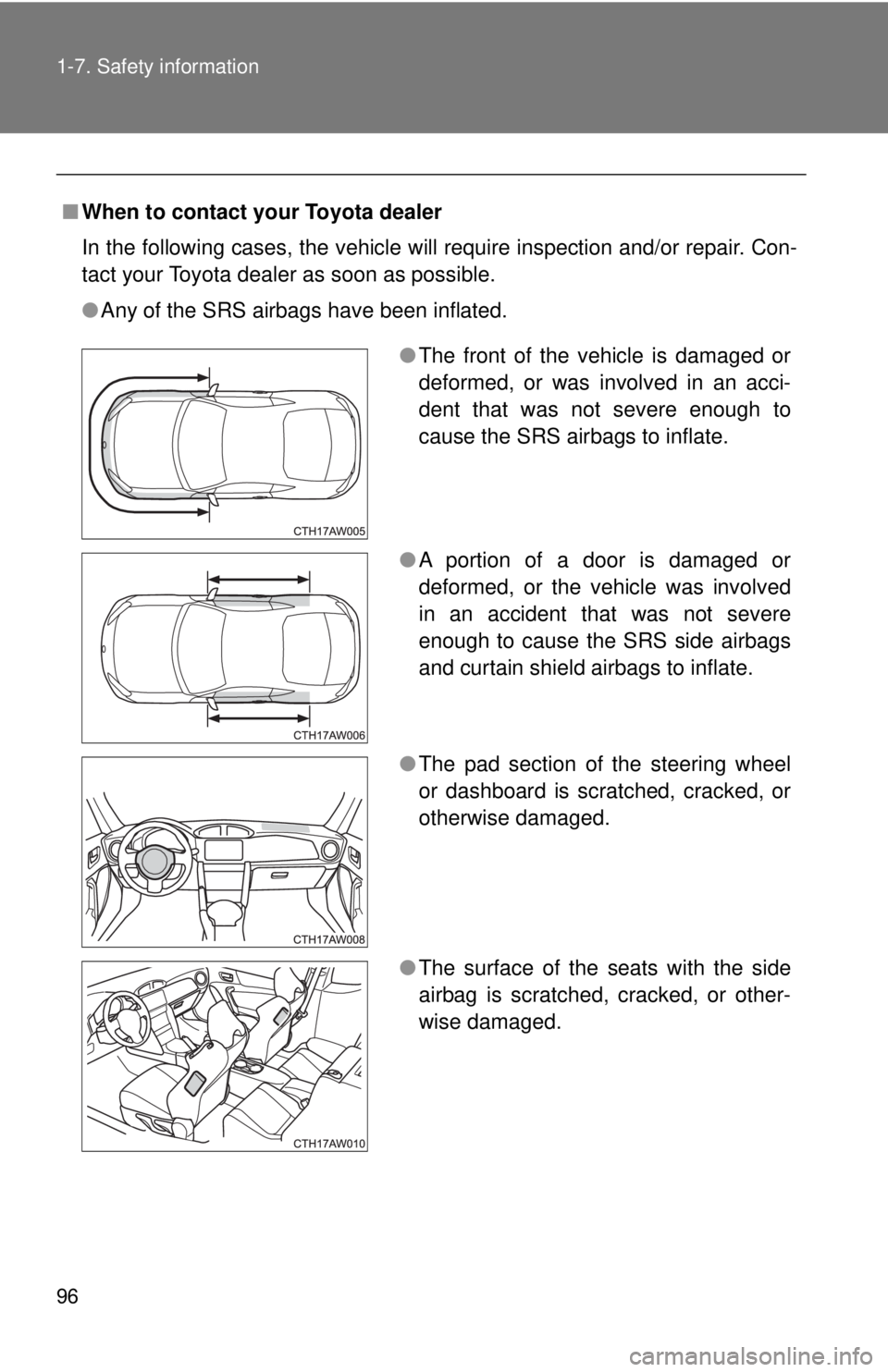
961-7. Safety information
■ When to contact your Toyota dealer
In the following cases, the vehicle will require inspection and/or repair. Con-
tact your Toyota dealer as soon as possible.
● Any of the SRS airbags have been inflated.
● The front of the vehicle is damaged or
deformed, or was involved in an acci-
dent that was not severe enough to
cause the SRS airbags to inflate.
● A portion of a door is damaged or
deformed, or the vehicle was involved
in an accident that was not severe
enough to cause the SRS side airbags
and curtain shield airbags to inflate.
● The pad section of the steering wheel
or dashboard is scratched, cracked, or
otherwise damaged.
● The surface of the seats with the side
airbag is scratched, cracked, or other-
wise damaged.
Page 97 of 428
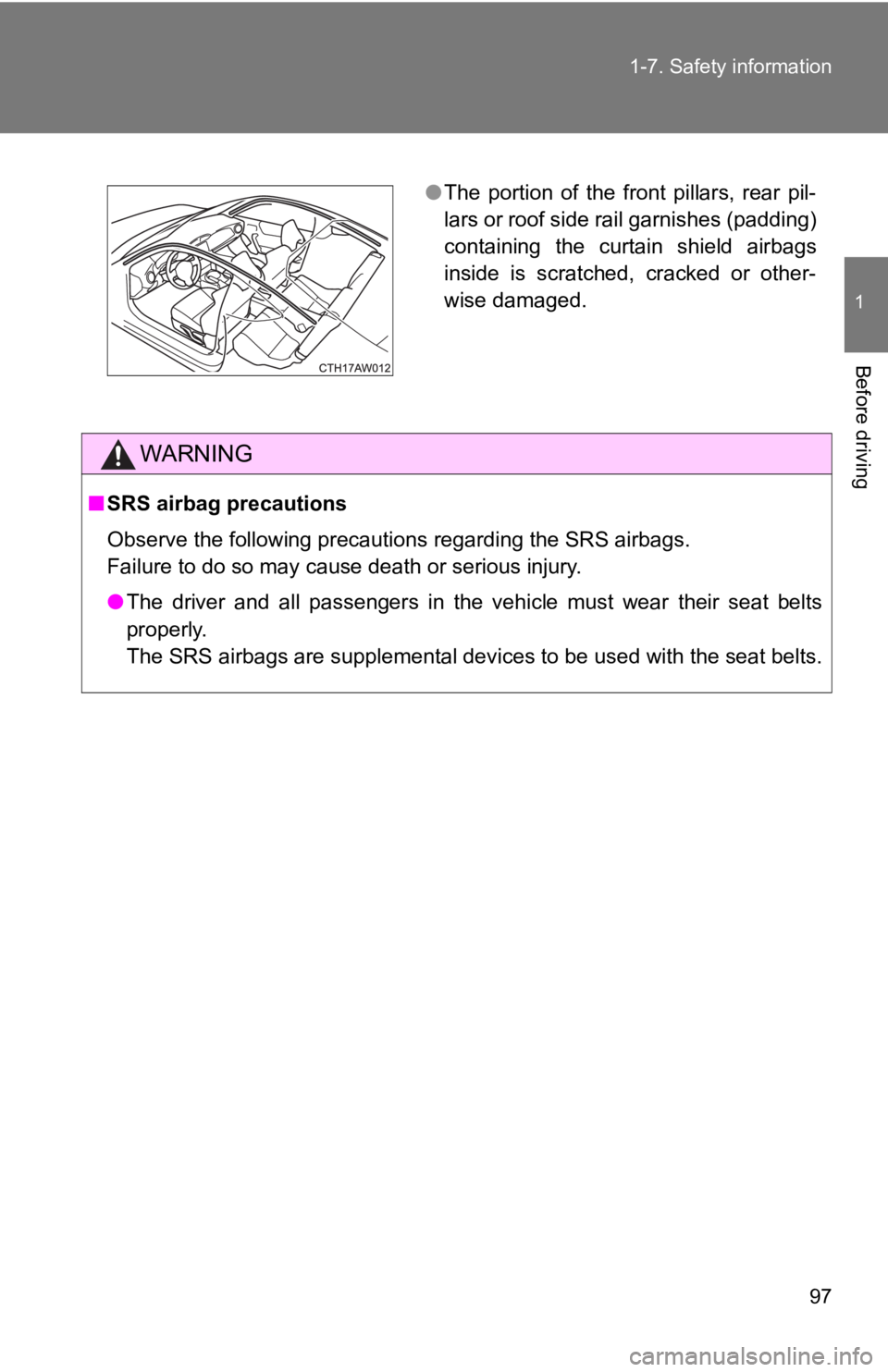
971-7. Safety information
1
Before driving
WARNING■ SRS airbag precautions
Observe the following precautions regarding the SRS airbags.
Failure to do so may cause death or serious injury.
● The driver and all passengers in the vehicle must wear their seat belts
properly.
The SRS airbags are supplemental devices to be used with the seat belts. ● The portion of the front pillars, rear pil-
lars or roof side rail garnishes (padding)
containing the curtain shield airbags
inside is scratched, cracked or other-
wise damaged.
Page 98 of 428

981-7. Safety information
WARNING■ SRS airbag precautions
● The SRS driver airbag deploys with considerable force, and can cause
death or serious injury especially if the driver is very close to the airbag.
The National Highway Traffic Safety Administration (“NHTSA”) advises:
Since the risk zone for the driver’s airbag is the first 2 - 3 in. (50 - 75 mm)
of inflation, placing yourself 10 in. (250 mm) from your driver airbag pro-
vides you with a clear margin of safety. This distance is measured from the
center of the steering wheel to your breastbone. If you sit less than 10 in.
(250 mm) away now, you can change your driving position in several
ways:
• Move your seat to the rear as far as you can while still reaching the
pedals comfortably.
• Slightly recline the back of the seat. Although vehicle designs vary,
many drivers can achieve the 10 in. (250 mm) distance, even with the
driver seat all the way forward, simply by reclining the back of the seat
somewhat. If reclining the back of your seat makes it hard to see the
road, raise yourself by using a firm, non-slippery cushion, or raise the
seat if your vehicle has that feature.
• If your steering wheel is adjustable, tilt it downward. This points the air-
bag toward your chest instead of your head and neck.
The seat should be adjusted as recommended by NHTSA above, while
still maintaining control of the foot pedals, steering wheel, and your view of
the instrument panel controls.
● The SRS front passenger airbag also deploys with considerable force, and
can cause death or serious injury especially if the front passenger is very
close to the airbag. The front passenger seat should be as far from the air-
bag as possible with the seatback adjusted, so the front passenger sits
upright.
● Improperly seated and/or restrained infants and children can be killed or
seriously injured by a deploying airbag. An infant or child who is too small
to use a seat belt should be properly secured using a child restraint sys-
tem. Toyota strongly recommends that all infants and children be placed in
the rear seats of the vehicle and properly restrained. The rear seats are
safer for infants and children than the front passenger seat. ( → P. 112)
Page 99 of 428
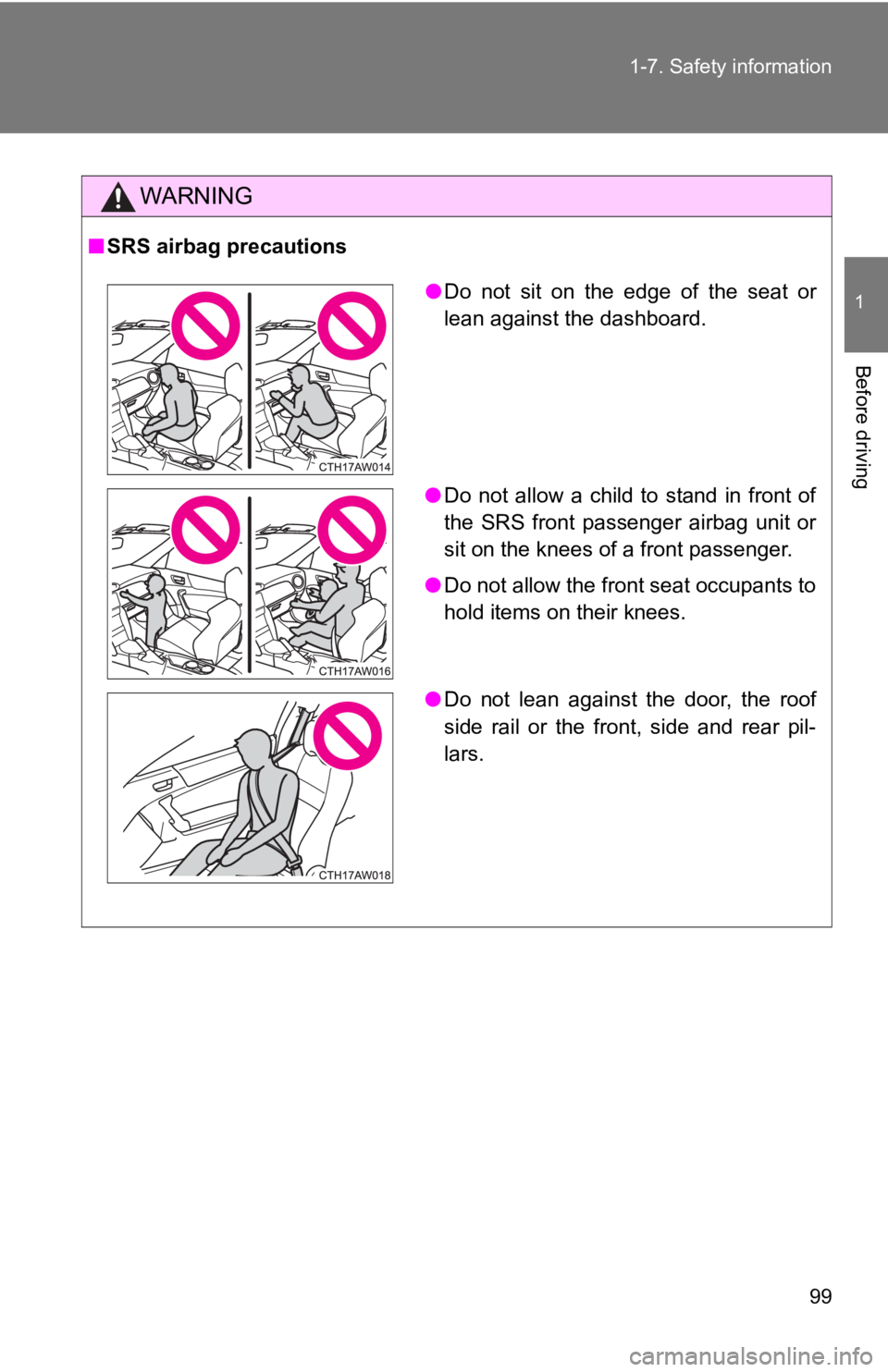
991-7. Safety information
1
Before driving WARNING■ SRS airbag precautions
● Do not sit on the edge of the seat or
lean against the dashboard.
● Do not allow a child to stand in front of
the SRS front passenger airbag unit or
sit on the knees of a front passenger.
● Do not allow the front seat occupants to
hold items on their knees.
● Do not lean against the door, the roof
side rail or the front, side and rear pil-
lars.
Page 100 of 428
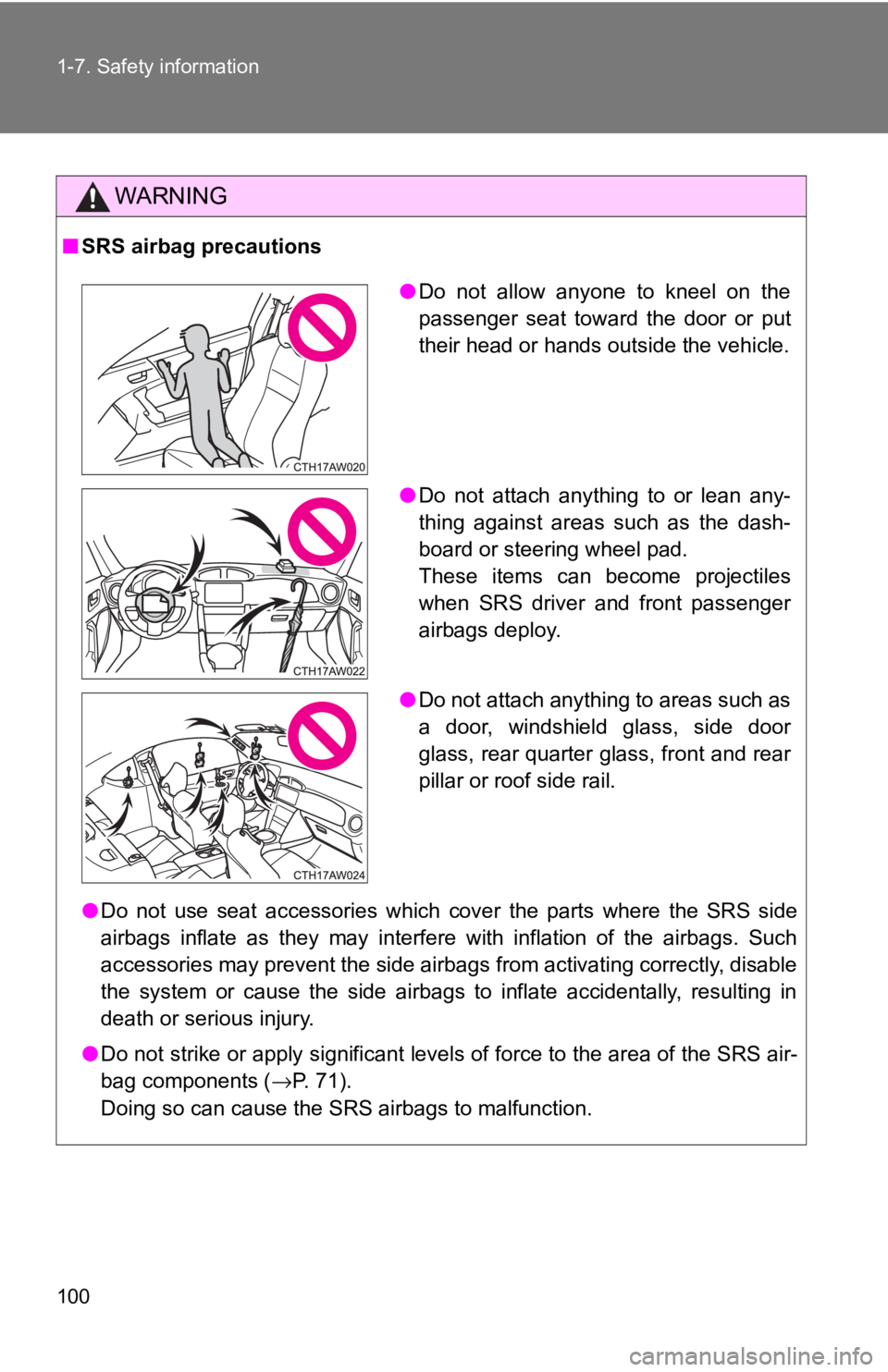
1001-7. Safety information
WARNING■ SRS airbag precautions
● Do not use seat accessories which cover the parts where the SRS side
airbags inflate as they may interfere with inflation of the airbags. Such
accessories may prevent the side airbags from activating correctly, disable
the system or cause the side airbags to inflate accidentally, resulting in
death or serious injury.
● Do not strike or apply significant levels of force to the area of the SRS air-
bag components ( → P. 71).
Doing so can cause the SRS airbags to malfunction. ● Do not allow anyone to kneel on the
passenger seat toward the door or put
their head or hands outside the vehicle.
● Do not attach anything to or lean any-
thing against areas such as the dash-
board or steering wheel pad.
These items can become projectiles
when SRS driver and front passenger
airbags deploy.
● Do not attach anything to areas such as
a door, windshield glass, side door
glass, rear quarter glass, front and rear
pillar or roof side rail.